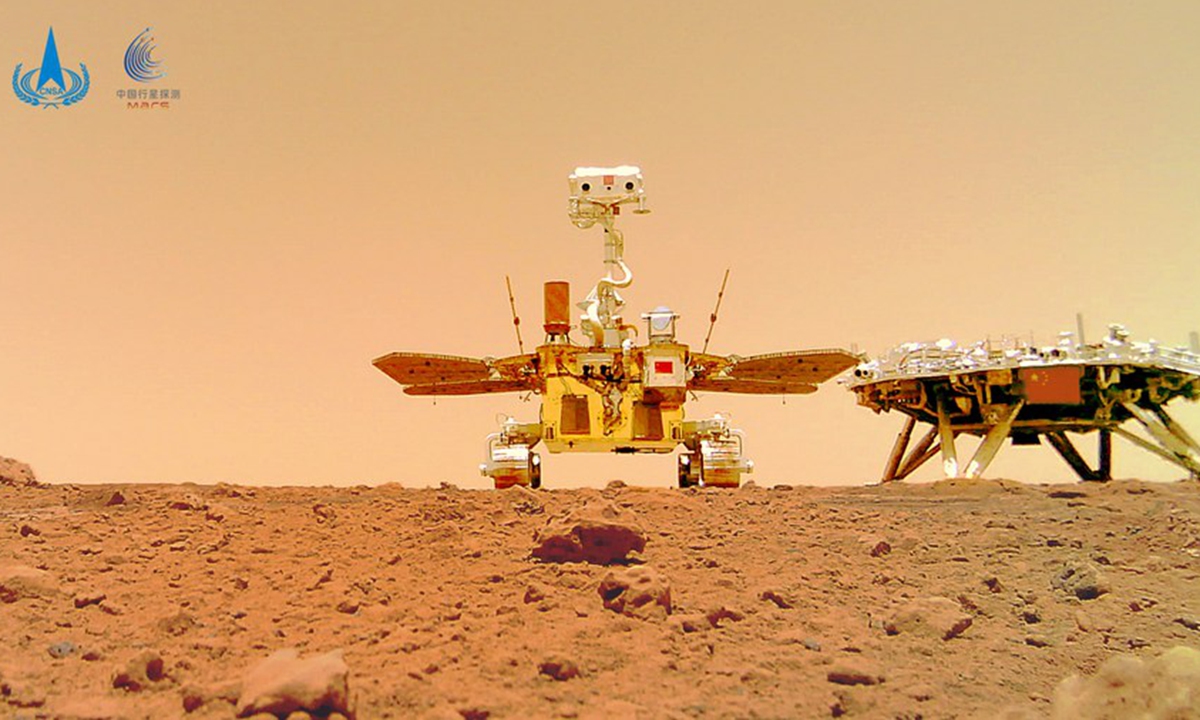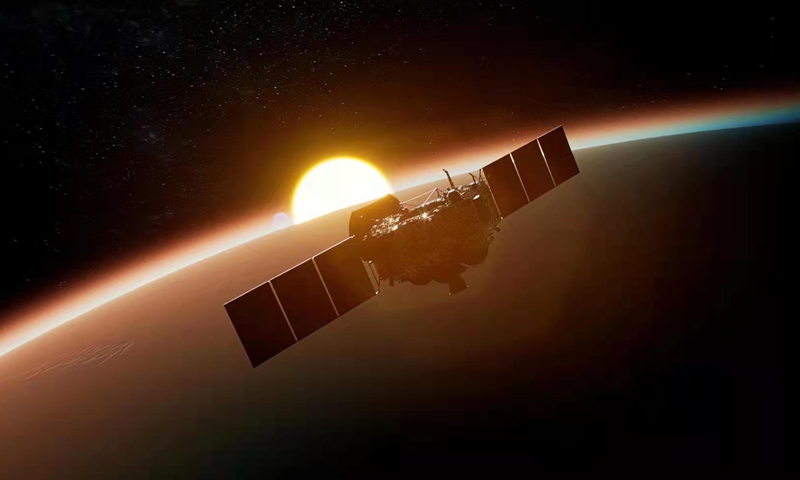
Photo released on June 11, 2021 by the China National Space Administration (CNSA) shows a selfie of China's first Mars rover Zhurong with the landing platform. (CNSA/Handout via Xinhua)
China's Zhurong Mars rover - the country's first deep-space probe exploring the Red Planet - has once again embarked on its trek of scientific exploration after safely surviving almost a month of solar outage, during which time the probe lost contact with the Earth and relied on its own smart autonomous systems.
The successful "survival" of Zhurong, as well as the valuable data acquired during this period, which has been a first in China's aerospace history, is invaluable experience for future deep-space missions, including that to Jupiter and the Mars sample retrieving mission, experts noted.
The good news came on Friday from China National Space Administration's China Lunar Exploration Project, announcing that Tianwen-1 Mars orbiter and Zhurong rover will continue with its scientific exploration after a safe passage through a period of solar outage.
In late September, the communication between the probe and the Earth began experiencing blackouts due to disturbances caused by the Sun's radiation, which was caused by a phenomenon known as solar outage when the Earth and Mars fall on either side of the Sun in alomost a straight line.
The loss of contact with the remote voyager worried many Chinese netizens, whose fears and anticipations struggled just like any parents seeing off their children to a faraway land - concerned by the unknown while also having faith in its capabilities.
To ensure the probe's safety during the "blackout," ground control team has suspended its exploration tasks and prepared a slew of measures, such as setting up in advance an autonomous working state and laying out possible conditions that it may encounter and their solutions, so that it can scrape off risks beforehand.
The probe also has the ability to control its own operating system, and can remain self-guiding during any solar outage period, resuming communication with the ground once the period is over.

Photo: Courtesy of China Aerospace Science and Technology Corporation
While communication links are blocked, Chinese research fellows were able to track and observe the orbiter and rover's status, and acquired some valuable first-hand data with the help of many international institutions from Europe, Australia, Russia, and South Africa.
Jiao Weixin, a space science professor at Peking University, believed the experience has tested China's deep-space exploration capabilities in both maintaining the probe's safety while also continuing its observation when ground control is unable to support the expedition.
"Solar outage is a common phenomenon when we explore celestial bodies in the solar system, especially with Mars and other celestial bodies close to the Sun. The successful experience on our country's first try has fully demonstrated our extensive preparation work, which will further help China's future deep-space missions, including that to Jupiter," Jiao told the Global Times on Friday.
Pang Zhihao, a Beijing-based space expert and retired researcher from the China Academy of Space Technology, told the Global Times on Friday that with the successful Moon sample retrieving mission of Chang'e-5 and the Tianwen-1 mission which withstood multiple challenges in one go, a Mars sample retrieving mission can be expected in the next few years, around 2028 to 2030.
During its next chapter, Zhurong will continue on its adventure on the Red Planet and travel south of the landing site to an area of suspected mud volcanoes detected by the Tianwen-1 orbiter.
The area has not been closely examined before by any other country with many believing it could contain evidence of the existence of water or life, which could have been brought out of the ground through eruptions of the mud volcanoes, Jiao said.
Launched on July 23, 2020 and landing on the Martian surface on May 15 this year, China's Tianwen-1 orbiter has been in orbit for over 450 days. The Zhurong rover has also worked for more than 150 days, greatly exceeding its expected lifespan of 90 days.





